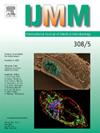菟丝子苷抗菌活性的优化及光谱表征
IF 3.6
3区 医学
Q1 MICROBIOLOGY
引用次数: 0
摘要
lugdunensis葡萄球菌是一种新兴的凝固酶阴性葡萄球菌(con)病原体,由于其产生lugdunin(一种含噻唑烷的抗菌肽)而引起越来越多的兴趣。然而,直接评估S. lugdunensis产生的lugdunin活性的标准化方案仍然缺乏。在这项研究中,我们检测了pH和孵育时间对lugdunensis活性的影响,并评估了S. lugdunensis分离物对一组革兰氏阳性和革兰氏阴性菌株产生的lugdunin的抗菌谱。菌株CGMH-SL85的最佳抑菌条件为pH 7.5,孵育72 h。在实验条件下,CGMH-SL85生产的lugdunin对5种革兰氏阳性菌株有抗菌活性,分别是金黄色葡萄球菌ATCC29213和溶血葡萄球菌CGMH-SH53,其次是屎肠球菌EF029和EF081-2以及单核增生李斯特菌ATCC10403S。然而,对11种革兰氏阴性细菌均无抗菌活性。此外,在47株不产生lugdunin的菌株(14株序列型(ST)4、27株序列型(ST27)和6株序列型(ST29))中观察到4种不同的lugdunin敏感性表型,其中A型具有大而清晰的抑制区;B型具有较小的、清晰的区域;C型表现为晕状抑制带;D型没有可检测到的活性。20株lugdunensis(42.6 %)呈现C型表型。值得注意的是,6株ST29菌株均表现为C型表型,而只有ST27菌株(3株)表现为A型表型。总之,我们制定了一个标准化的方案来评估lugdunin的活性,使用pH 7.5和72小时的潜伏期,发现不同的S. lugdunensis菌株表现出不同的lugdunin敏感性表型。本文章由计算机程序翻译,如有差异,请以英文原文为准。
Optimization and spectrum characterization of the antibacterial activity of lugdunin
Staphylococcus lugdunensis, an emerging coagulase-negative Staphylococcus (CoNS) pathogen, has garnered increasing interest due to its production of lugdunin, a thiazolidine-containing antimicrobial peptide. However, standardized protocols for directly assessing lugdunin activity produced by S. lugdunensis remain lacking. In this study, we examined the effects of pH and incubation duration on lugdunin activity and evaluated the antibacterial spectrum of lugdunin produced by S. lugdunensis isolates against a panel of gram-positive and gram-negative bacterial strains. The optimal conditions for lugdunin antibacterial activity of isolate CGMH-SL85 were identified as pH 7.5 and a 72-h incubation period. Under the tested conditions, the lugdunin produced by CGMH-SL85 exhibited antimicrobial activity against five gram-positive strains, including Staphylococcus aureus ATCC29213 and Staphylococcus haemolyticus CGMH-SH53, followed by Enterococcus faecium EF029 and EF081–2 and Listeria monocytogenes ATCC10403S. However, no antibacterial activity was observed against any of the 11 tested gram-negative bacterial species. Furthermore, four distinct lugdunin susceptibility phenotypes were observed among 47 lugdunin-nonproducing S. lugdunensis strains (14 sequence type (ST)4, 27 ST27, and 6 ST29 strains), including Type A characterized by large, clear inhibition zones; Type B with smaller, clear zones; Type C displaying halo-like inhibition zones; and Type D showing no detectable activity. Moreover, 20 S. lugdunensis strains (42.6 %) exhibited the Type C phenotype. Notably, all six ST29 strains displayed the Type C phenotype, while the Type A phenotype was observed only among ST27 strains (3 strains). In conclusion, we developed a standardized protocol for evaluating lugdunin activity, using pH 7.5 and a 72-h incubation period, and found that different S. lugdunensis strains exhibited distinct lugdunin susceptibility phenotypes.
求助全文
通过发布文献求助,成功后即可免费获取论文全文。
去求助
来源期刊
CiteScore
9.70
自引率
0.00%
发文量
18
审稿时长
45 days
期刊介绍:
Pathogen genome sequencing projects have provided a wealth of data that need to be set in context to pathogenicity and the outcome of infections. In addition, the interplay between a pathogen and its host cell has become increasingly important to understand and interfere with diseases caused by microbial pathogens. IJMM meets these needs by focussing on genome and proteome analyses, studies dealing with the molecular mechanisms of pathogenicity and the evolution of pathogenic agents, the interactions between pathogens and host cells ("cellular microbiology"), and molecular epidemiology. To help the reader keeping up with the rapidly evolving new findings in the field of medical microbiology, IJMM publishes original articles, case studies and topical, state-of-the-art mini-reviews in a well balanced fashion. All articles are strictly peer-reviewed. Important topics are reinforced by 2 special issues per year dedicated to a particular theme. Finally, at irregular intervals, current opinions on recent or future developments in medical microbiology are presented in an editorial section.

 求助内容:
求助内容: 应助结果提醒方式:
应助结果提醒方式:


